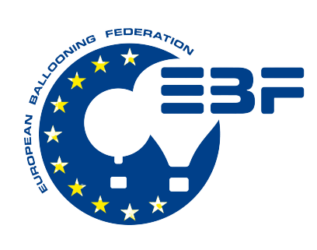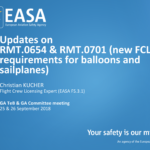Mid-way to the end of the “Opt-Out” voted by most European countries in October 2014, here is an update of our work and progress.
EBF have now become EASA’s main ballooning contact. If things go as planned, European balloonists should have a « balloon book », gathering all rules specific to ballooning, and specifically built for balloonists, instead of texts adapted from fixed-wings rules. This is the direct consequence of our work, combined with EASA’s “GA Road-Map”s credo which is to create “simpler, lighter and better rules”.
This may be a an electronic book covering FCL/BAC Ops DTO Part Med, ARA ORA and other rules applicable to balloons. It will however be a consolidated version and is still under discussion.
We have mainly worked on 3 tasks: Air Operations, Licences, Training.
AIR OPS : a set of rules applicable to commercial and non-commercial flights. This is the first « RMT » (Rule Making Task ») on which we have worked, with meetings all through 2014-15-16, and the publication of an Opinion in January 2016.The idea was to take ballooning out of Commercial Air Transport (CAT) in order to simplify operations, make them less costly and with less paperwork. A simple declaration will replace the AOC. The jury is still out but we have good hopes that we will succeed. News will follow as soon as it is available. CPB (Commercial Passenger Ballooning) will be introduced instead of CAT. All this to:
- Point out the differences between ballooning and other GA disciplines.
- Avoid references to Air Transport
- Allow the development of specific rules
- Define and distinguish the Basic rules (BAS) applicable to all pilots, and the additional ones (ADD) applicable to commercial pilots.
You can find the Opinion published on 6/01/2016 :
http://www.easa.europa.eu/system/files/dfu/01%20Opinion%20No%2001-2016
Part AIR OPS Ballooning should be voted by the EC at the beginning of 2017.
FCL: licences.
As this RMT was started in July of 2016 and is going as fast as possible. EASA have limited resources and have dedicated some of these to this working group., EBF’s Executive Committee went to Cologne in March 2016 to meet Patrick Ky, EASA’s Executive Director, and Dominique Roland, GA Director. The agency proposed that EBF could take the leadership on this task, and create a task force, (TF) with a limited number of people, all specialists. We have nominated a TF President, Paul Spellward from the UK, and several experts have joined the group, which counts 12 people : 1 representing EASA, 4 EBF experts, (Paul Spellward Chairman, Phil Dunnington, Karel Abbenes and Jean Donnet) 2 manufacturers, (Kubicek and Ultramagic) and 5 NAAs (Belgium, Czech Republic, France, Germany, UK).
The first meeting took place in July, the second in October and the 3rd should be taking place early 2017, although EASA’s limited resources make it difficult to fix a date.
The general idea is to have only one licence for balloon pilots (so no more « LAPL B “), and then ratings for different competences (commercial, instructor, etc..) with corresponding medical requirements. EBF are doing their maximum to accelerate the progress of this task, and the task force should have finished their work before the end of 2017, but it already seems unlikely that the new licences will be available in April 2018. 2019 or even 2020 are mentioned as new dates.
Training outside ATO
Last May, EASA created a TF to work on the theme: « Training outside ATO », to train non-commercial pilots. Several options were examined, and the rather complicated EASA rules certainly did not help. RTO (Registered Training Organization) was rejected, then BTO, and the TF pushed the idea of a “DTO” « Declared Training Organisation”, which has been accepted.
DTO global concept is a declared organization, which may train initial training students as well as instructors (FI) and examiners. The Aviation Authority (NAAs) will evaluate the structure during the year, but the structure just has to send a declaration to start instructing. Minimum requirements are an annual safety review and an activity report.
A manual is not compulsory.
The Opinion: https://www.easa.europa.eu/document-library/opinions/opinion-112016) has been published, to be voted by EASA Comittee in March of 2017, and presented to the EC.
GA RoadShow
EASA have been organizing in 2016 a « GA Roadshow”, in several countries, together with the NAAs, to inform stakeholders about the changes in GA. To date, the roadshow took place in Austria, France, Germany and Sweden. EBF president was invited as a speaker to Paris roadshow.
EBF membership
EBF member states are now: Austria, Belgium, Czech Republic, Denmark, France, Holland and the UK. If you represent a national balloonist body in your country, and you want to join, please fill in the application form available on the website: www.ballooning-federation.eu.
To reach EBF’s Executive Committee, ask for more detail, sign in, please contact one of us:
Patricia Lamy (FR) : pla@ballooning-federation.eu
Karel Abbenes: (NL) kaa@ballooning-federation.eu
Phil Dunnington: (UK) phd@ballooning-federation.eu
Philippe de Cock : (Be) pdc@ballooning-federation.eu
Jan Andersen: (Denmark) jan@ballooning-federation.eu
Thomas Herndl: (AU) thh@ballooning-federation.eu




 EBF welcomes Spain as a new member! Neus Llado, who comes from a well known family of balloonists in Barcelona, is the Spanish representative.
EBF welcomes Spain as a new member! Neus Llado, who comes from a well known family of balloonists in Barcelona, is the Spanish representative.